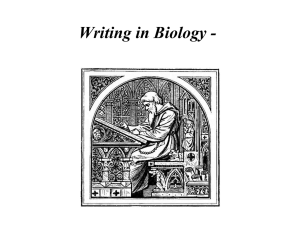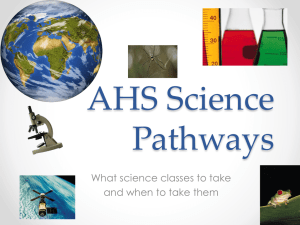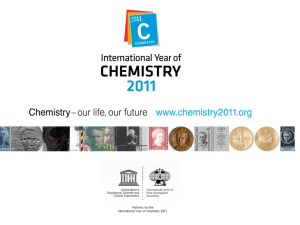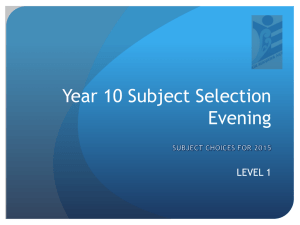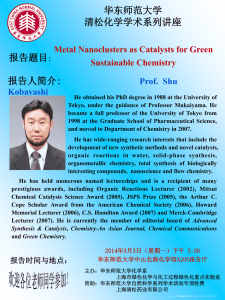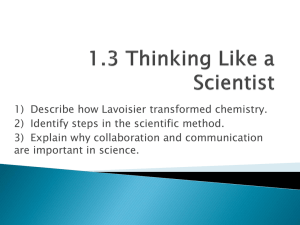Stephen Pruitt & Maria Ferguson - Next Generation Science Standards
advertisement
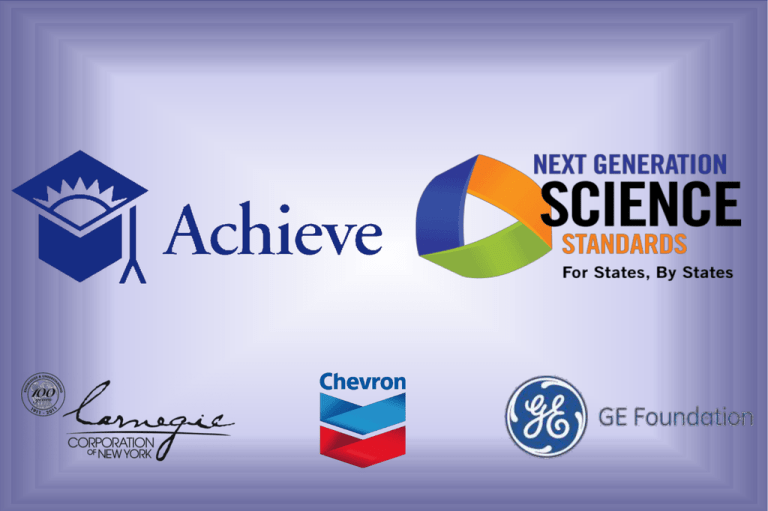
Science Education: Facts and Trends in High School, College, and Career The National Look Trends in science course-taking using High School Transcript Study (1990, 2000 & 2009) data High School Science Course-taking 100 80 96 91 70 60 Biology Chemistry 40 Physics 49 Geology/Earth Science Biology, chemistry, and physics 36 20 21 25 28 19 0 1990 2009 30 STEM-related CTE Course Credits 2000 2005 2009 Agriculture 12 12 11 Computer & information science 24 20 21 Engineering technologies 14 12 11 Health sciences 11 10 10 Manufacturing 16 16 13 Repair & transportation 9 9 8 • The percentage of high school graduates taking STEM-related career and technical education courses in high school has remained steady or decreased. AP, IB, and Other Honors Courses 25 22 20 15 16 AP/honors biology AP/honors chemistry 10 AP/honors physics 5 5 0 3 1990 • 2 6 2000 4 6 6 2009 The percentages of students taking Advanced Placement, International Baccalaureate, or other honors science courses have risen, especially in biology. Science Course-taking by Race/Ethnicity 1990 Biology Chemistry Physics Biology & chemistry Bio, chem & physics • 2009 2000 White Black Hisp Asian White Black Hisp Asian White Black Hisp Asian 92 91 90 90 92 92 88 88 96 96 95 96 52 40 38 64 63 60 52 75 72 65 66 85 23 15 13 38 32 25 23 54 38 27 29 61 50 40 36 60 60 58 50 71 69 64 64 83 20 12 10 33 26 20 18 47 31 22 23 54 The percentage of white, black, Latino, and Asian students taking science courses increased. Gaps in Science Course-taking by Race/Ethnicity 60.0 50.0 40.0 White Black 30.0 Hispanic 20.0 Asian 10.0 0.0 1990 2000 2009 • There are significant gaps among racial/ethnic subgroups of students taking a science curriculum consisting of biology, chemistry, and physics. Science Course-taking by Gender 1990 2000 2009 Male Female Male Female Male Female 90 92 89 93 95 96 48 50 58 65 67 73 25 18 34 29 39 33 47 49 54 64 65 71 22 16 26 24 32 28 Biology Chemistry Physics Bio & chemistry Bio, chemistry & physics • Overall, more male students completed a curriculum that includes biology, chemistry and physics than did their female counterparts. Science Course-taking by SES 2000 2009 Graduates in the highest income schools Graduates in the lowest income schools Graduates in the highest income schools Graduates in the lowest income schools Biology 91% 91% 96% 96% Chemistry 65% 61% 76% 69% Physics 35% 35% 47% 27% Bio & Chemistry 62% 60% 75% 68% Bio, Chemistry & Physics 29% 26% 40% 23% For this analysis, a highest-income school was defined as one where fewer than 25% of students were eligible for free/reduced lunch, whereas a lowest-income school was one where more than 75% of students were eligible. 1990 was not included because of insufficient data. • The gap in science course-taking between the highest- and lowest-income schools widened, except in biology. The High School Look Trends in science graduation requirements Science Credit Requirements for a Standard High School Diploma Number of States 7 4 10 • Most states (30) require a minimum of three science credits to graduate high school with a standard diploma. Not specified 1 credit 2 credits 3 credits 30 4 credits Science Course Requirements for a Standard High School Diploma 25 Number of States Biology 20 15 10 5 0 No specific courses 21 Lab 16 Student option 14 Physical 11 9 Chemistry 2 2 Life 1 1 Physics Enviromental Courses Required for a Standard Diploma Note: Sixteen states do not require specific courses and 11 state require certain courses from a series (for example, on state requires biology, physics or chemistry , and a third additional science credit. • More states require students to complete a biology course to earn a standard diploma than other types of science courses, such as chemistry or physics. States Requiring Science Exit Exams between 2002 and 2014 25 Number of States 20 Number of states requiring a science exit exam 15 10 Number of states requiring a biology exit exam 5 2014 2012 2011 2010 2009 2008 2007 2006 2005 2004 2003 2002 0 Year • In 2002, three states required a biology exit exam; by 2014, six states administered such an exit exam. The College Admissions Look Trends in science requirements for college admissions 4-year Postsecondary Sample by Governance Public 4-year: State-level governance Kansas Kentucky Maryland Nevada Washington West Virginia Public 4-year: Institution-level governance (6) California Delaware District of Columbia Illinois Iowa Minnesota New Jersey New York Oregon Rhode Island Vermont Wyoming (12) Highly selective private 4-year Universities California Institute of Technology Columbia Dartmouth Duke Harvard Massachusetts Institute of Technology Princeton Stanford University of Chicago University of Pennsylvania Yale Colleges Amherst Bowdoin Carleton Claremont McKenna Davidson Haverford Middlebury Pomona Swarthmore Wellesley Williams (20) Four-Year Public and Private Postsecondary Science Requirements by Credit 1 Number of credits 4 credits 3 credits 12 2 2 credits 7 1 credit 10 Public 4-year requirements Private 4-year requirements or recommendations 1 5 No credits/Not specified 0 2 4 6 8 10 Number of colleges/universities 12 12 14 • 12 out of 28 public colleges and universities in our sample require three credits; 2 of the 22 private universities and liberal arts colleges require or recommend three science credits Four-Year Public and Public Postsecondary Science Requirements by Course Laboratory Public 4-year requirements 3 Biology Course 16 6 6 Physical Chemistry and/or physics 1 1 Biology, chemistry, and/or… 1 8 Other 7 2 0 Private 4-year requirements or recommendations 2 4 6 8 10 12 14 16 18 Number of colleges/universities • The most commonly required science course for admission into a public college or university in our sample is a laboratory science course. These types of courses could incorporate any science subject or a combination of subjects. Two-Year Public Postsecondary Science Admissions Requirements Laboratory Biology Course Physical Chemistry and/or physics Biology, chemistry, and/or physics Other 1 High school transcript/diploma or GED 5 Not specified 12 0 2 4 6 8 10 12 14 Number of colleges Twelve of the eighteen two-year colleges in the sample do not have specific science course requirements for admission into the college. The College Major Prerequisite Look Trends in science recommendations and requirements for STEM majors Sample Postsecondary Institutions for STEM major prerequisites Sample State California Sample Public 4-Year Institutions California State University (CSU), Long Beach California State University (CSU), Northridge University of California (UC), Davis University of California (UC), Los Angeles Delaware Delaware State University University of Delaware District of Columbia The University of the District of Columbia Kansas Kentucky Fort Hays State University Kansas State University University of Kansas Wichita State University Eastern Kentucky University University of Kentucky University of Louisville Western Kentucky University Sample Public 2-Year Institutions Barstow Community College Delaware Technical Community College The University of the District of Columbia Community College Northwest Kansas Technical College Hazard Community and Technical College Sample Postsecondary Institutions for STEM major prerequisites (continued) Sample State Maryland Rhode Island Vermont Washington Sample Public 4-Year Institutions Morgan State University Salisbury University Towson University University of Maryland, College Park Rhode Island College University of Rhode Island Castleton State College Lyndon State College University of Vermont Eastern Washington University University of Washington Washington State University Western Washington University Sample Public 2-Year Institutions Anne Arundel Community College Community College of Rhode Island Vermont Technical College Clover Park Technical College STEM majors: Chemistry, Computer Science, Electrical Engineering, Environmental Science, Life Sciences/Biology, Petroleum Engineering, and Physics. High School Science Recommendations and Requirements for STEM Majors • In general, two-year community and technical colleges do not require or have specific recommendations about high school science courses. • Where course taking information was available for the sample of for-profit institutions used in this study, the major providers do not require or have specific recommendations about high school science courses. Science in “Bright Outlook” Careers Trends in STEM careers using Department of Labor’s ONET database ONET Job Zones • Zone 1: Little or no preparation needed • Zone 2: High School Diploma • Zone 3: Training in vocational school, related on-the-job experience, or an associate’s degree • Zone 4: Four-year bachelor’s degree • Zone 5: Graduate school (a master’s, Ph.D., M.D., or J.D.) Zone Sample Selection • A comparison of both STEM and non-STEM careers in our sample shows that STEM careers generally require higher levels of preparation than non-STEM careers. 4% 20% 6% 16% 18% Zone 1 Zone 2 Zone 3 Zone 4 Zone 5 24% 32% 20% 60% Sample of STEM bright outlook careers in ONET zones Sample of non-STEM bright outlook careers in ONET zones Knowledge Needed for Bright Outlook STEM and Non-STEM Jobs All Jobs in Sample STEM Jobs Non-STEM Jobs 1. English language 1. English language 1. English language 2. Mathematics 2. Mathematics 2. Customer & personal service 3. Customer & personal service 3. Computers & electronics 3. Administration & management 4. Computers & electronics 4. Engineering & technology 4. Mathematics 5. Admin & management 5. Administration & management 5. Computers & electronics 6. Engineering & technology 6. Design 6. Education & training 7. Education & training 7. Customer & personal service 7. Public Safety 8. Design 8. Biology 8. Psychology 9. Sales & marketing 9. Physics 9. Sales & marketing 10. Psychology 10. Production & processing 10. Clerical Most Important Knowledge Areas for Zone 4 and 5 Jobs. • For Zone 4 jobs: Mathematics, Computers and Electronics, Engineering and Technology, and Design • For Zone 5 jobs: Mathematics, Biology, Computers and Electronics, and Medicine and Dentistry Zone 4: 4-year college degree 1. English language 2. Mathematics 3. Computers & electronics 4. Engineering & technology 5. Customer Service 6. Administration & management 7. Design 8. Clerical 9. Economics & accounting 10. Law & government Zone 5: Graduate degree 1. English language 2. Education & training 3. Mathematics 4. Biology 5. Customer service 6. Psychology 7. Computers & electronics 8. Administration 9. Medicine & dentistry 10. Therapy & counseling Most Important Skills for Bright Outlook Jobs All Jobs STEM Jobs Non-STEM Jobs 1. Active listening 1. Critical thinking 1. Active listening 2. Critical thinking 2. Active listening 2. Speaking 3. Speaking 3. Reading comprehension 3. Critical thinking 4. Reading comprehension 4. Complex problem-solving 4. Reading comprehension 5. Complex problem solving 5. Speaking 5. Social perceptiveness 6. Judgment & decision making 6. Judgment & decision making 6. Judgment & decision making 7. Monitoring 7. Active learning 7. Service orientation 8. Writing 8. Writing 8. Monitoring 9. Social perceptiveness 9. Science 9. Coordination 10. Service orientation 10. Mathematics 10. Writing Major Points to Take Away • More high school students are taking more science courses but gender and race/ethnicity gaps still exist. • High school science course requirements and college admissions science requirements are not well aligned. • There is still work to be done to ensure students are well prepared for STEM majors and to ensure that minority, low income and female students enter and remain in the STEM pipeline. Major Points to Take Away • The ONET database points out the overlap between the knowledge and skill areas that are deemed important for career success and the content knowledge/skills/practices embedded in the NGSS. • The NGSS supports what research has made clear: Students need to engage in science and engineering practices as they learn content. The high-level thinking skills, communication skills, and argumentation from evidence practices within the NGSS align well with the skills requirements needed for bright outlook careers as defined by ONET. Major Points to Take Away • Knowledge and skills in STEM-related areas is a valuable commodity in the bright outlook job market, even beyond just STEM careers. • A rigorous science curriculum based on the NGSS can provide all students with the kind of foundational knowledge and skills they need to pursue bright outlook careers in both STEM and non-STEM fields.

